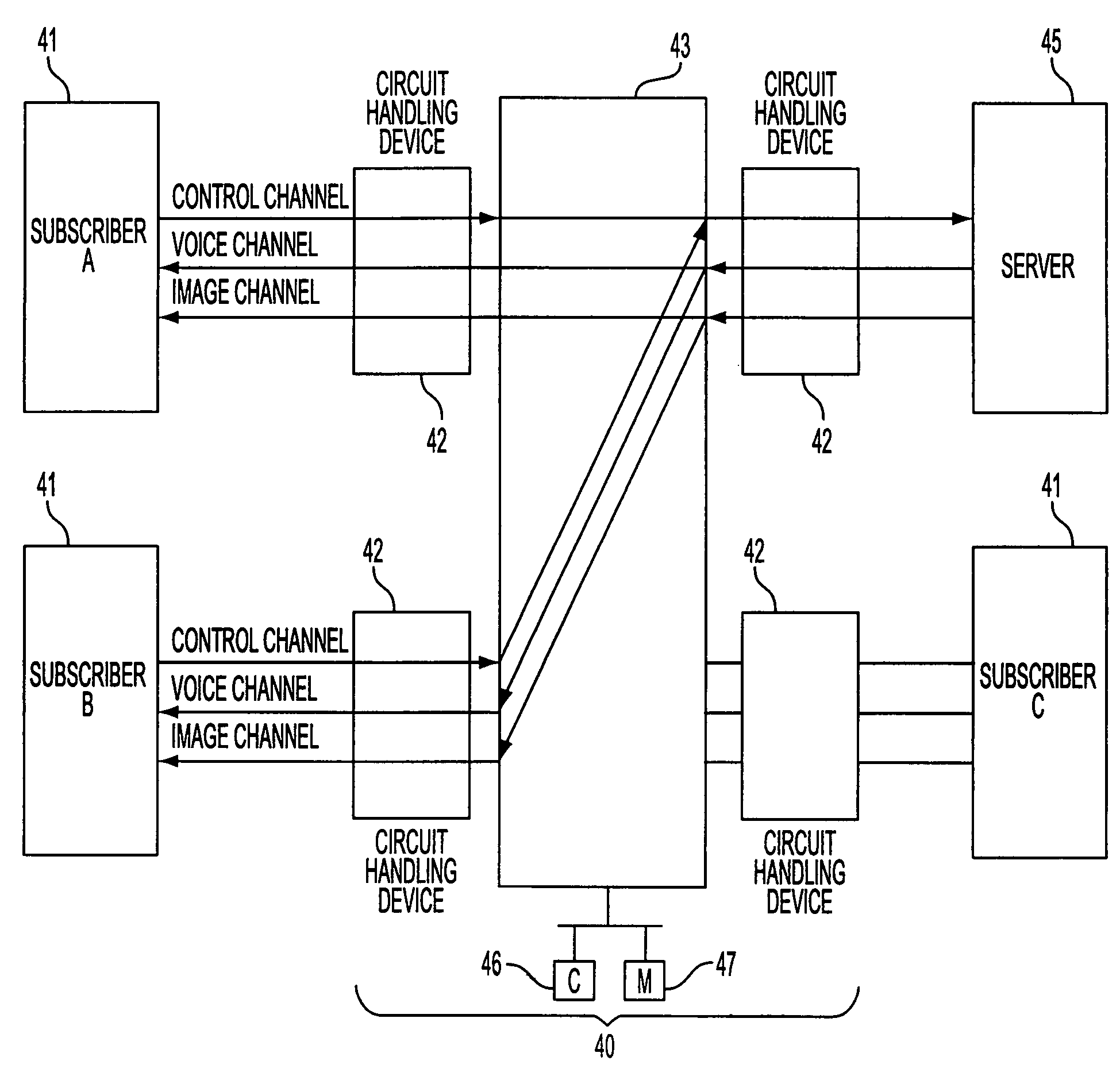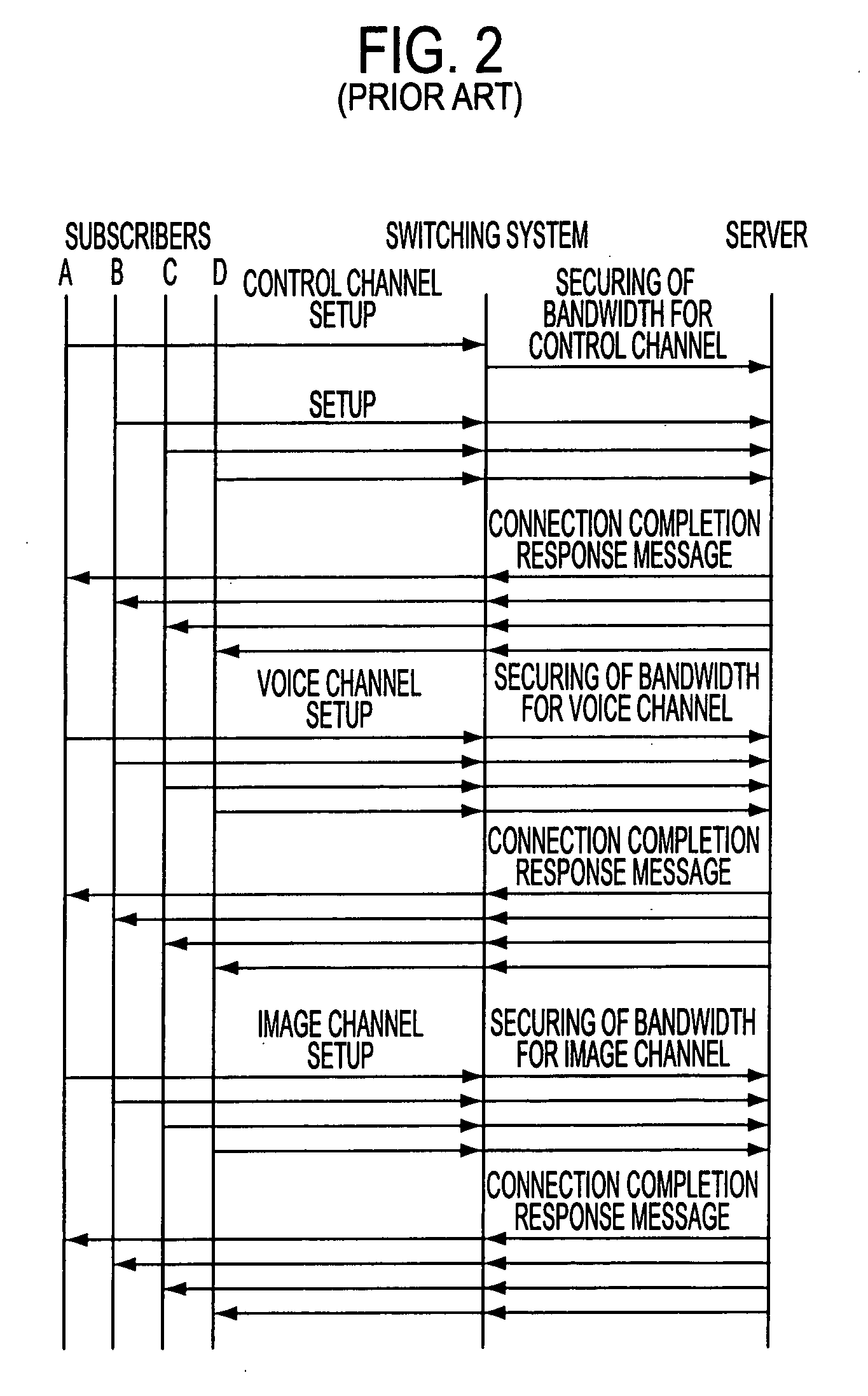Path setting control method and switching system
a control method and control method technology, applied in data switching networks, two-way working systems, frequency-division multiplexes, etc., can solve the problems of no remaining bandwidth, no image channel setting for subscribers, no longer being able to make image channel settings, etc., to achieve efficient secure a bandwidth for all paths
- Summary
- Abstract
- Description
- Claims
- Application Information
AI Technical Summary
Benefits of technology
Problems solved by technology
Method used
Image
Examples
first embodiment
[0055]FIG. 4 is a flow chart illustrating an operational process for securing a bandwidth with the switching system 40 shown in FIG. 3 in accordance with the present invention. As shown in FIG. 4, the switching system 40 determines whether or not a received message is a SETUP message (one of the call setting requests) from a subscriber (step A1). If the received message is a SETUP message, bandwidth for all of the paths required (PA1 to PAn) is calculated, including the bandwidth of its own path (PA1), for as many paths as there are required to provide the service for the subscriber (step A2). Next, the available bandwidth and the calculated bandwidth are compared (step A3). If the calculated bandwidth is less than or equal to the available bandwidth, the calculated bandwidth is secured to provide the service (step A4). Only the path PA1 of the service subscriber A is first set by the SETUP message, and the message is then sent to a following switching system 40 or to the server 45 ...
second embodiment
[0071]FIG. 8 is a flow chart of an operational process for path setting in accordance with the present invention. As shown in FIG. 8, in step B1, the switching system 40 determines whether or not a SETUP (call setting request) message is received from the subscriber. Since the number of paths required to provide the service for the subscriber is set in the SETUP message for a first path, as described previously, a determination is made whether or not as many SETUP messages have been received as there are number of paths (step B2). If the same number of SETUP messages have been received as there are number of paths, the entire bandwidth corresponding to the number of paths is calculated (step B3). Next, the available bandwidth and the calculated bandwidth are compared (step B4).
[0072]If the available bandwidth is less than the calculated bandwidth, the path setting cannot be made, and a connection disable message is sent to the subscriber to release the subscriber (step B7). If the a...
fourth embodiment
[0078]FIG. 12 is an explanatory diagram of operation for securing a bandwidth for channels in accordance with the present invention. As shown in FIG. 12, the subscribers A, B, C and D, the switching system 40 and the server 45 are indicated with vertical lines. Subscribers A, B, C and D send SETUP (call setting request) messages to the switching system 40 in order secure the bandwidth from large to small of the various bandwidth for paths required to provide the service. For example, subscriber A sends the SETUP messages for the image channel (3 Mbps) at the beginning. Next, the subscriber A sends the SETUP messages for the voice channel (64 Kbps) and then the SETUP messages for the control channel (64 Kps).
[0079]The switching system 40 secures bandwidth for the various SETUP messages from subscribers A, B, C and D and sends the respective messages to the server 45. As a result, by first setting a bandwidth, such as that required by the image channel, there is a greater possibility ...
PUM
 Login to View More
Login to View More Abstract
Description
Claims
Application Information
 Login to View More
Login to View More - R&D
- Intellectual Property
- Life Sciences
- Materials
- Tech Scout
- Unparalleled Data Quality
- Higher Quality Content
- 60% Fewer Hallucinations
Browse by: Latest US Patents, China's latest patents, Technical Efficacy Thesaurus, Application Domain, Technology Topic, Popular Technical Reports.
© 2025 PatSnap. All rights reserved.Legal|Privacy policy|Modern Slavery Act Transparency Statement|Sitemap|About US| Contact US: help@patsnap.com



